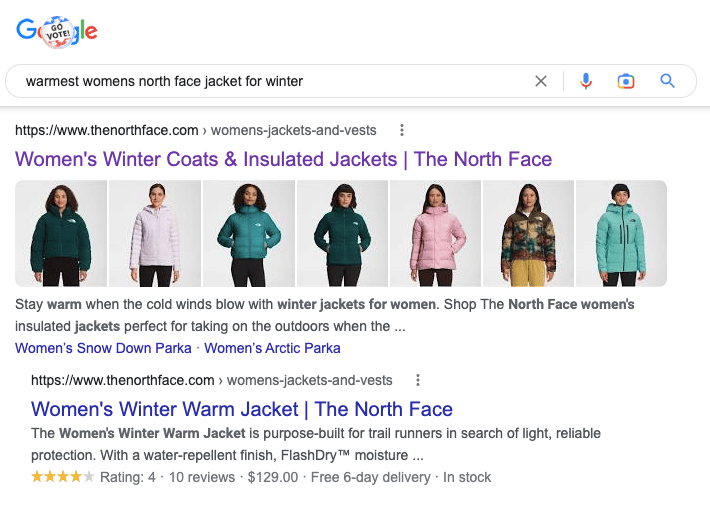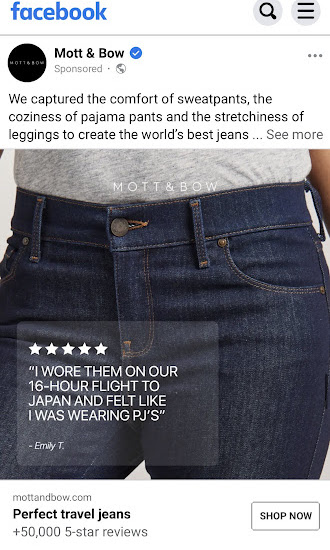How Product Reviews Help Brands Compete in an Economic Downturn (and 3 Ways to Maximize Their Impact)

We’re in the midst of a lot of economic uncertainty. Turn on the news or open a web browser and you’re sure to be bombarded with headlines about hiring freezes, rising inflation and interest rates, decreased spending, and a possible recession looming around the corner.
In times of economic uncertainty, it’s not uncommon for consumers to tighten their budgets and look for opportunities to save. Research from McKinsey & Company found that nearly three-quarters (74%) of consumers in the US are “trading down” – most commonly by adjusting the quantity or size of essential items and delaying purchases of non-essentials.
As consumers’ spending habits shift, brands and retailers are on the hunt for ways to remain competitive.
Shoppers are becoming more price sensitive. But if you hope to turn a profit, slashing your prices across the board isn’t exactly practical. Or, you could double down on advertising to get in front of more shoppers in more places. But that comes at a steep cost.
The good news is, there’s one powerful tool you can tap into to stay competitive during an economic downturn. And chances are, it’s one you’re already using: ratings and reviews.
In this blog, we’ll explore why ratings and reviews matter in a downturn – and three ways you can start maximizing the impact of this content.
Reviews Boost Traffic
By now, we all know that a growing portion of retail sales are happening online. According to Digital Commerce 360, in the second quarter of 2022, eCommerce accounted for more than 20% of total retail sales in the U.S.
In addition, while overall holiday sales are expected to remain relatively flat, Deloitte predicts eCommerce sales will grow between 12.8% and 14.3%.
In a perfect world, a consumer would navigate directly to your dot com whenever they were in the market for something you offered. But the reality is, the path to an online purchase typically starts in one of two places:
- Google or another search engine
- Amazon
The higher your product page ranks in those search engine results, the more likely a shopper is to click on it. According to an analysis from Backlinko, the #1 result in an organic Google search has an average clickthrough rate of more than 27%. Conversely, less than 1% of Google searches clicked on a result from page two.
Improving your search rank – both on Google and Amazon – must be a priority. There are myriad factors that determine your search rank. One is the presence of product reviews.
Reviews Boost Your Search Rank – and Product Page Traffic
Reviews are rich with keywords that customers use when describing your products. Search engines crawl this content, which makes it easier for shoppers to find it. According to data from PowerReviews, on average, organic traffic to a product page increases by 108% after adding even one review.
Plus, if your dot com uses Schema.org standards) which is basically an agreed-upon standard for structuring website content), Google can also pull star ratings and the number of reviews into search engine results. This content can catch shoppers’ attention – and increase their likelihood of clicking through.

Reviews Boost Your Rank on Amazon
There are many factors that determine where your product pages rank on Amazon – and to be honest, it can seem like a big mystery what those factors are. But we do know that a high volume of positive reviews positively impacts your seller authority. And the better your seller authority, the higher your product pages will rank for relevant keywords.
Take a deeper dive into the impact of reviews on Google and Amazon search rank in this blog.
Reviews Increase Conversion
When times are tough, shoppers put more thought into purchase decisions. They want to be confident they’re making smart purchase decisions and choosing products they’ll get a lot of value from.
Content from brands – including written descriptions, photos, and videos – certainly helps. But increasingly, shoppers want to read the unbiased opinions of others like them. They do so by reading reviews. Our research found that 74% of consumers find reviews to be at least somewhat important when making a purchase decision.
Reading reviews boosts shoppers’ confidence. And confident shoppers are more likely to convert. An analysis from PowerReviews found that even a single review results in a conversion lift of 76.7%.
Reviews also boost offline sales. Bazaarvoice recently commissioned Forrester to complete a Total Economic Impact™ Of Bazaarvoice study. One interviewee for the study was an employee at a CPG electronics organization, partnering with Bazaarvoice for review collection. The company found that for every dollar spent on online purchases after interacting with review content, $3.76 was also spent in-store.
Engaging with Reviews Boosts Conversion and Loyalty
The bad news is, even a single negative review can cause a consumer to steer clear of a product. Our own research found that 78% of consumers have changed their mind about making a purchase after reading a negative review. In an economic downturn, this is a risk you simply can’t afford.
78% of consumers have changed their mind about making a purchase after reading a negative review.
1440, Consumer Reviews and Q&A Expectations Survey
But the occasional negative review is inevitable. And the good news is, responding to those negative reviews can turn things around. For starters, responding is an important way to restore the shoppers’ trust. Per Salesforce research, 80% of consumers will forgive a company for a mistake after receiving excellent service.
80% of consumers will forgive a company for a mistake after receiving excellent service.
Salesforce State of the Connected Customer 5th Edition
What’s more, responding to a negative review also increases the confidence of future shoppers. Our research found that 83% of consumers would reconsider a product with a negative review if there was a sufficient response from the brand or manufacturer.
83% of consumers would reconsider a product with a negative review if there was a sufficient response from the brand or manufacturer.
1440, Consumer Reviews and Q&A Expectations Survey
While the value of responding to negative reviews is clear, it’s also important to respond to positive reviews. Doing so helps you build connections with happy customers, which fosters loyalty and increases lifetime value. What’s more, it shows future shoppers you value your customers and their opinions.
3 Ways to Maximize the Impact of Reviews
In the best of times, ratings and reviews are a powerful way to grow traffic, conversion, and loyalty. In times of economic uncertainty, this content is even more important.
If you’re not already, now’s the time to invest in a ratings and reviews program. The right ratings and reviews partner can help you generate more, high quality content on the review channels that matter most for your business. And you can expect a large return on your investment. Per the Total Economic Impact™ Of Bazaarvoice, companies can see a 400% ROI from investing in Bazaarvoice; in other words, $4 earned for every $1 spent.
And a solution like Reputation Studio from 1440 can consolidate all reviews across all key channels into a single platform, which makes this content a lot easier to manage.
Or, maybe you’ve already started collecting ratings and reviews. If that’s the case, here are three practical tips for getting more ROI from this content during an economic downturn.
Tip #1: Collect More Reviews
Earlier, we mentioned that displaying a single review boosts conversion. But that same PowerReviews analysis found that the more reviews, the greater the impact on conversion. If you display 5,000 reviews, you can expect a conversion lift of nearly 293%!
The takeaway? Start collecting more reviews.
If you’re already working with a ratings and reviews provider, increasing your review volume doesn’t require a ton of time, effort or investment. For starters, make sure you’re sending automated requests for reviews after a customer has made a purchase, either by email or SMS. And don’t be afraid to follow up with a second request. According to a PowerReviews survey, 28% of consumers say they need to be asked twice before they’ll write a review.
In addition, take a deep dive to determine product pages that are particularly in need of additional reviews. For example, pages with no reviews – or those that have a high volume of traffic, but low conversion. Double down on your efforts to collect reviews for these key products.
Tip #2: Amplify the Reach of Reviews by Including Them in Other Marketing Initiatives
 Consumers trust reviews because they’re written by others like them, with no motive other than helping other shoppers. Of course, it makes sense to prominently feature reviews on your product pages. But think beyond the product page – and look for opportunities to infuse this confidence-boosting content into your other marketing initiatives.
Consumers trust reviews because they’re written by others like them, with no motive other than helping other shoppers. Of course, it makes sense to prominently feature reviews on your product pages. But think beyond the product page – and look for opportunities to infuse this confidence-boosting content into your other marketing initiatives.
For example, include star ratings and snippets of reviews in your digital marketing campaigns, including social media, display and email.
In addition, remember that ratings and reviews influence offline purchases too. At a bare minimum, make sure your review display is optimized for mobile. That way, shoppers can easily find, sort, and read this content when they’re shopping in a brick-and-mortar store. In addition, look for opportunities to incorporate star ratings and excerpts from positive reviews into print advertising, catalogs, and even in-store signage.
Check out more examples of how brands incorporate reviews into their marketing initiatives.
Tip #3: Start Responding to Reviews Across Channels
Responding to negative reviews can help you turn bad situations around. And responding to positive reviews gives you an opportunity to strengthen relationships with happy customers. As such, it’s important to consistently respond to reviews, regardless of sentiment.
But the reality is, consistently responding takes a lot of time – especially if you collect reviews across multiple platforms. And we’re willing to bet you don’t have a whole lot of time to spare.
A solution like Reputation Studio from 1440 can make it a lot easier (and a lot less time consuming) to respond to reviews.
Reputation Studio consolidates all reviews written on your dot com and any other review platforms you use. That means you can avoid logging into a dozen different platforms. And because Reputation Studio is built for Salesforce, your agents can manage responses alongside other support channels. This also allows you to keep all key customer information within a single, familiar platform: Salesforce.
In addition, Reputation Studio allows you to house response review response templates that your customer service agents can use as a starting point when responding to reviews. Of course, these templates shouldn’t be copied and pasted as-is. But they do serve as a great place to start, which can save your agents a whole lot of time.
When it comes to review responses, not all reviews warrant the same level of urgency. With Reputation Studio, you can set alerts when a review comes through with a certain star rating or that includes certain keywords. That way, you can respond to the most urgent reviews as quickly as possible.
Start Leveraging Reviews to Remain Competitive in an Economic Downturn
The entire globe is in the midst of economic uncertainty. Consumers are watching their spending more closely than usual. And many are giving more thought to purchasing decisions.
But that doesn’t mean brands and retailers are doomed. Those that effectively leverage reviews can continue to attract, convert, and retain customers – even in an economic downturn.